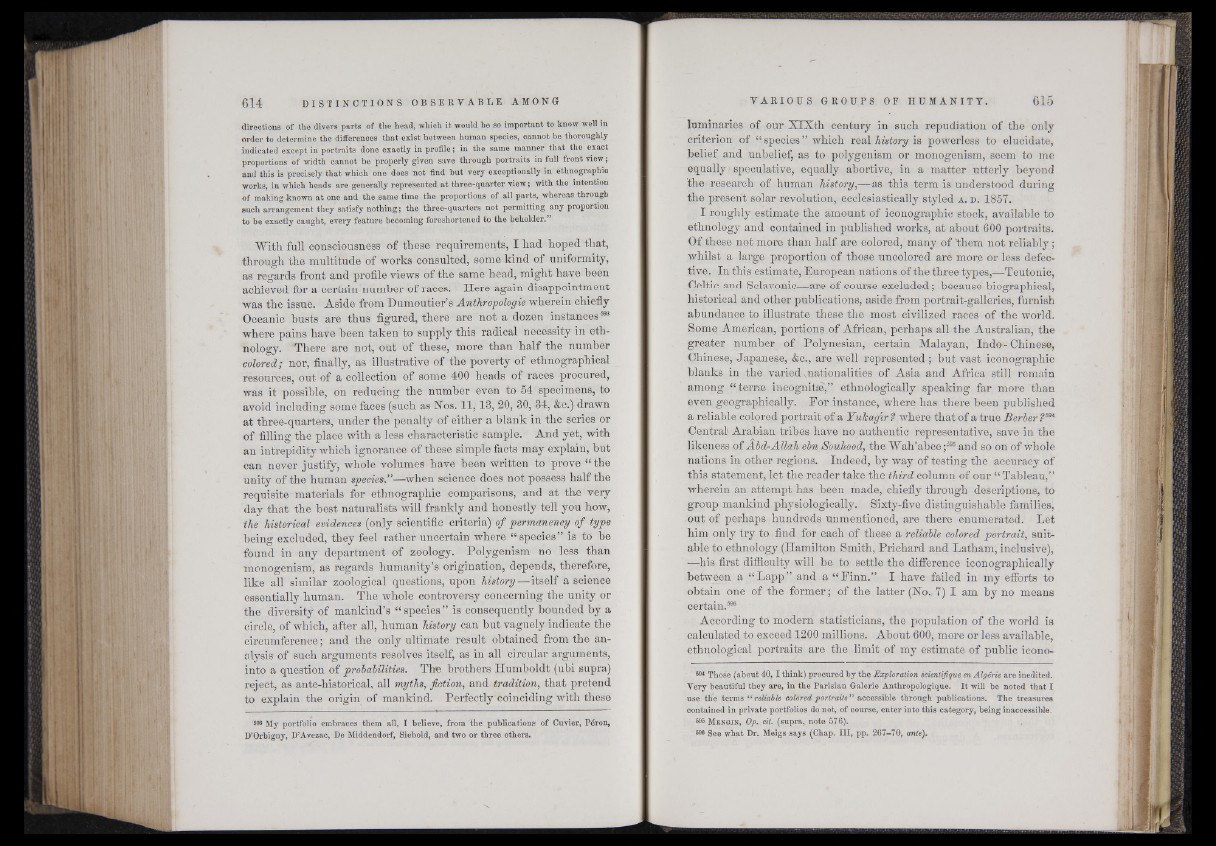
directions of the divers parts of the head, which it would be so important to know well in
order to determine the differences that exist between human species, cannot be thoroughly
indicated except in portraits done exactly in profile; in the same manner that the exact
proportions of width cannot be properly given save through portraits in full front view;
and this is precisely that which one does not find but very exceptionally in ethnographic
works, in which heads are generally represented at three-quarter view; with the intention
of making known at one and the same time the proportions of all parts, whereas through
such arrangement they satisfy nothing; the three-quarters not permitting any proportion
to be exactly caught, every feature becoming foreshortened to the beholder.”
With full consciousness of these requirements, I had hoped that,
through the multitude of works consulted, some kind of uniformity,
as regards front and profile views of the same head, might have been
achieved for a certain number of races. Here again disappointment
was the issue. Aside from Dumoutier’s Anthropologie wherein chiefly
Oceanic busts are thus figured, there are not a dozen instances593
where pains have been taken to supply this radical necessity in ethnology.
There are not, out of these, more than half the number
colored; nor, finally, as illustrative of the poverty of ethnographical
resources, out of a collection of some 400 heads of races procured,
was it possible, on reducing the number even to 54 specimens, to
avoid including some faces (such as Nos. 11,13, 20, 30, 34, &c.) drawn
at three-quarters, under the penalty of either a blank in the series or
of filling the place with a less characteristic sample. And yet, with
an intrepidity which ignorance of these simple facts may explain, hut
can never justify, whole volumes have been written to prove “ the
unity of the human species—when science does not possess half the
requisite materials for ethnographic comparisons, and at the very
day that the best naturalists will frankly and honestly tell you how,
the historical evidences (only scientific criteria) of permanency of type
being excluded, they feel rather uncertain where “ species” is to he
found in any department of zoology. Polygenism no less than
inonogenism, as regards humanity’s origination, depends, therefore,
like all similar zoological questions, upon history—itself a science
essentially human. The whole controversy conperning the unity or
the diversity of mankind’s “ species” is consequently hounded by a
circle, of which, after all, human history can hut vaguely indicate the
circumference; and the only ultimate result obtained from the analysis
of such arguments resolves itself, as in all circular arguments,
into a question of probabilities. The brothers Humboldt (ubi supra)
reject, as ante-historical, all myths, fiction, and tradition, that pretend
to explain the origin of mankind. Perfectly coinciding with these
893 My portfolio embraces them all, I believe, from the publications of Cuvier, Péron,
D’Orbigny, D’Avezac, De Middendorf, Siebold, and two or three others.
luminaries of our NLXth century in such repudiation of the only
criterion of “ species” which real history is powerless to elucidate,
belief and unbelief, as to polygenism or monogenism, seem to me
equally | speculative, equally abortive, in a matter utterly beyond
'the research of human history,—as this term is understood during
the present solar revolution, ecclesiastically styled a . d . 1857.
I roughly estimate the amount of iconographie stock, available to
ethnology and contained in published works, at about 600 portraits.
Of these not more than half are colored, many of ‘them not reliably ;
whilst a large proportion of those uncolored are more or less defective.
In this estimate, European nations of the three types,—Teutonic,
Celtic and Sclavonic-—are of course excluded ; because biographical,
historical and other publications, aside from portrait-galleries, furnish
abundance to illustrate these the most civilized races of the world.
Some American, portions of African, perhaps all the Australian, the
greater number of Polynesian, certain Malayan, Indo-Chinese,
Chinese, Japanese, &c., are well represented ; but vast iconographie
blanks in the varied vnationalities of Asia and Africa still remain
among “ terræ incognitæ,” ethnologically speaking far more than
even geographically. For instance, where has there been published
a reliable colored portrait of a Tulcagir ? where that of a true Berber ?594
Central' Arabian tribes have no authentic representative, save in the
likeness of Abd-Allah ebn Souhood, the Wah’abee ;395 and so on of whole
nations in other regions. Indeed, by way of testing the accuracy of
this statement, let the reader take the third column of our “ Tableau,”
wherein an attempt has been made, chiefly through descriptions, to
group mankind physiologically. Sixty-five distinguishable families,
out of perhaps hundreds unmentioned, are there enumerated. Let
him only try to find for each of these a reliable colored portrait, suitable
to ethnology (Hamilton Smith, Prichard and Latham, inclusive),
—his first difficulty will be to settle the difference iconographically
between a “ Lapp” and a “ Finn.” I have failed in my efforts to
obtain one of the former ; of the latter (No. 7) I am by no means
certain.596
According to modern statisticians, the population of the world is
calculated to exceed 1200 millions. About 600, more or less available,
ethnological portraits are the limit of my estimate of public icono-
594 Those (about 40, I think) procured by the Exploration scientifique en Algérie are inedited.
Very beautiful they are, in the Parisian Galerie Anthropologique. It will be noted that I
use the terms “ reliable colored portraits” accessible through publications. The treasures
contained in private portfolios do not, of course, enter into this category, being inaccessible.
695 Mengjn, Op. cit. (supra, note 576).
596 See what Dr. Meigs says (Chap. I ll, pp. 267-70, ante).